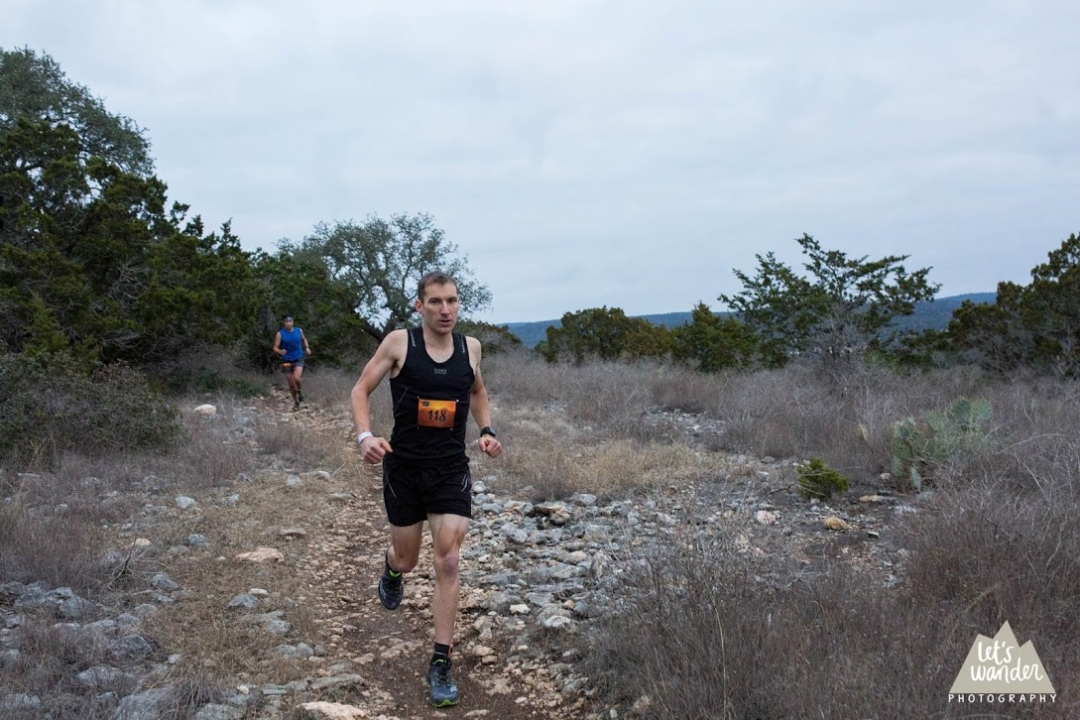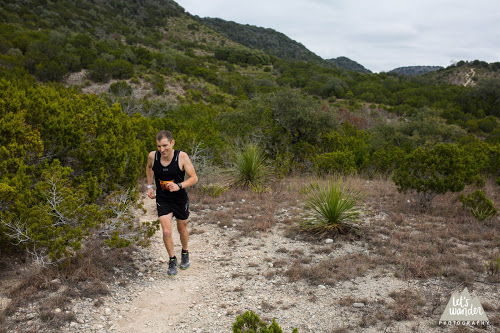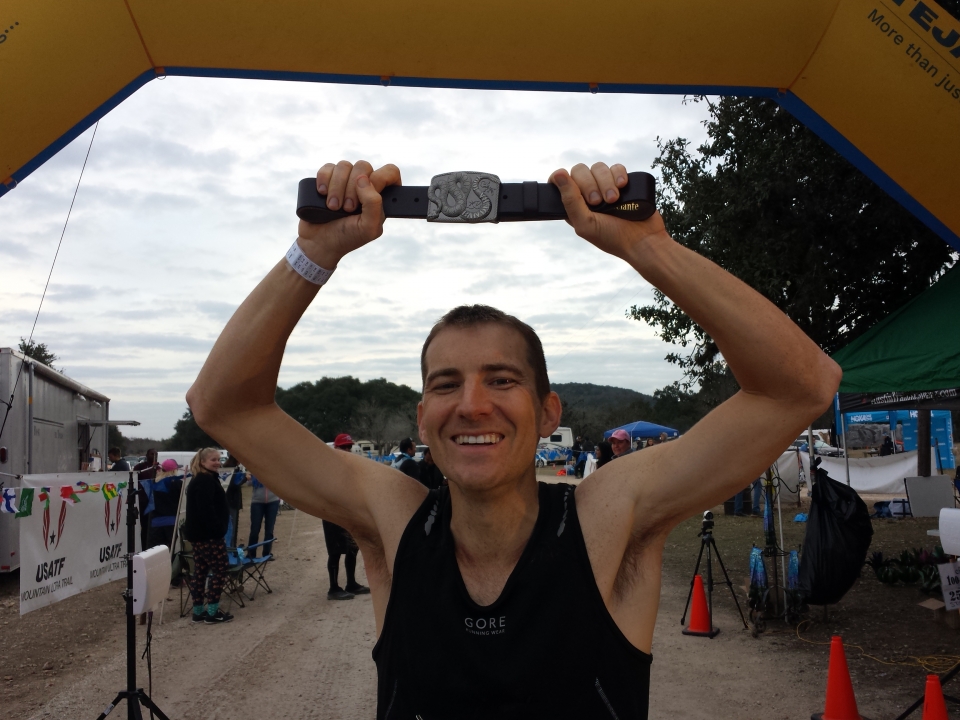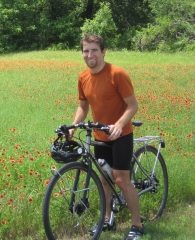Bandera 100k
Woke up at 5:30, exactly two hours before gun time. Not because I needed two hours to go through any kind of pre-race routine, but only to give myself some extra time to let breakfast settle. Oatmeal with cinnamon, a handful of nuts, and a banana. Perhaps a bit more oatmeal than I needed...and the same was true about how much I'd had the day before, at every meal. I have a tendency to nervously eat a little extra before a long race, because I'll "need the extra energy."
It was cold, but not deathly cold. I'd brought enough to bundle up, and slept well the night before, inside a van, on a twin mattress, inside a sleeping bag with a liner. It's always difficult to drag yourself out of a warm sleeping bag, but once I'd done so and piled on a bunch of clothes, it wasn't so bad.
Visited the port-o-potties about an hour before gun time, and there was already a sizeable line. I don't know if I've ever been to a race that had an adequate amount. They cost a lot to rent, but for $140, where else is the money going? It's not like roads need to be closed down, and there are only six aid stations.
After a few more pre-race rituals, and after stripping down to only a sleeveless shirt and shorts, I visited the toilet one more time, only a few minutes before gun time. This time, there were only four people in line, and all but one were volunteers, who let me go in front of them. Luckily managed to take care of business quickly, then made my way to the starting gate with about a minute to spare, weasling my way to about the middle of the pack.
I should've known better than to let myself start in the middle of the pack (people who would finish 5-6 hours after I would). For the first 5 km, I spent a lot of time stuck behind someone, which probably cost about 5 minutes. Since I'd lined up at the last minute, my watch didn't get a signal until we'd run about 0.8 km, in 4:15, according to a runner near me. I'd have to add that to my mental calculations from here on out.
It might have been a good thing that I was stuck behind slower runners, because the first section of the loop was one of the hardest parts, and with the adrenaline going from the start of the race, I was trying to run through everything full-speed.
About 5 km into the race, I found myself behind a short runner with pigtails, who, based on her form, was a solid runner. I immediately pegged her as a candidate to win the women's race, and figured following her pace wouldn't be a bad strategy. I stayed behind her for about 1 km, until the trail flattened and widened, when I moved to the side, stretched out my legs, and ran like I meant it.
For the first time, I was able to run. Up until this point, there had always been something preventing you from getting into a groove and truly running, whether that be inclines, rocks, other runners, or most likely, rocks. My goodness, the rocks. There were a lot of rocks. Sometimes big ones, embedded in the gournd, but more likely, loose rocks, anywhere between kiwi- and orange-sized, both on inclines and declines, which forced you to slow down, keep your head down, and pick your way through the terrain, instead of truly running. Finally, I could run.
By the time I arrived at the first aid station, I could tell I'd eaten too much the day before, and had no need to refuel here. I took some sport drink and move on, after hearing how I was a genius to use 3/4 of a single-use trail mix packet as my water bottle.
After doing arguably the hardest hill of the course before the first aid station, we were rewarded with another hill that was arguably the hardest of the course. With lots of rocks. And even more cactus than there was before. Sotol, in particular, which was technically not growing on the trail, but might as well have been. In case you don't know, this is sotol:
Now imagine that on both side of the trail, criss-crossing each other, so you have no choice but to crash through them like a saloon door, only a lot worse. The biggest concern was how long is this going to go on? Will the whole race be like this?? Before reaching the next aid station, my legs were ripped to shreds. Maybe wear those knee-high compression socks next time.
Ice Cream hill was steep enough that a little walking was necessary, but at least it wasn't long. There were a few other runners nearby I took it on, and one asked aloud, "You guys like ice cream?" I smiled to myself knowing there was some dulce de leche waiting in my freezer.
This was the part of the course with some of the most exposed ridgelines, meaning some of the best vistas. On the rare occasion the trail had few enough rocks that you didn't have to keep your head down, I looked out over the beautiful Texas Hill Country. This is my home. Even in winter, it's a beautiful place. I felt sorry for the out-of-towners running the race, who were probably questioning why they put themselves through life living anywhere else.
Conditions, by the way, were perfect. Cloudy all day, low of about 5 C, high of about 15 C. 10 C is perfect for running, which meant at the start it was a little cool, in the afternoon it was a little warm, but most of the time, it was ideal. There wasn't even any wind. I suppose you could've technically asked for better weather, exactly 10 C all day, and complaining is always an option. But realistically, this is as good as it gets.

Took in sports drink and a gel at the next aid station and kept moving. There were still 3-4 runners around and we more or less left the aid station together, mostly in high spirits, since there were essentially no hills for the next 20 km or so. Even the rocks began to subside.
Unfortunately, it was about this time my stomach started to turn. Over the next 30 km, I wound up having to take care of business no less than six times. Which probably hurt my finish time by at least six minutes, if not more, because having fireworks going off in your stomach doesn't make you run any faster. I should've eaten less the day before.
I still made reasonably good time in this section, again mostly because the terrain was flat and not rocky, so I was finally able to cruise, at least when my stomach decided it was OK to do so. I wound up seeing the same people multiple times, as they'd pass me when I'd make a pit stop, then I'd slowly catch up in between.
One guy wearing a white shirt and a black hydration vest finally asked, "Did I talk to you last night?" It was Mark, from Colorado! I hadn't gotten a good look at his face in the dark the night before, nor today, since when you're running, you only see people from behind. We exchanged pleasantries and commented on the possibility of finishing in ten hours. He sounded more optimistic than me at this point, but perhaps that was because he'd done this distance before. I hadn't, so I wasn't sure I'd hold out in the second half.
The two aid stations in the middle of the loop had particularly enthusiastic volunteers. One of them was cooking sausage wraps and pancakes. They smelled so good, but eating them would be a terrible idea, especially in my current condition. Even without that, I'd probably throw up or something. Later, other aid stations would start cooking potatoes, quesadillas, and chicken noodle soup. I stuck to sports drink, and at one of them, an orange slice.
In the last 10 km of the loop, I found myself in a group again, strong runners, from what I could tell. I started chatting with a guy named Joe, from San Antonio. I thought he was stuck behind me, but it turned out he liked my pace and was simply latching on. It felt like my stomach problems were over, but once we reached the top of the last hill, it suddenly turned and I had to stop immediately. The group kept running past, and I was back on the trail in 60 seconds. Even more than previous times, my stomach felt much better afterwards. That turned out to be the final stop. Evidently, there was no inventory left to clear.
I picked my way down one last rocky descent and saw Joe, plus about six other guys I'd been running with (and Camille, a tall skinny runner with flowing blonde locks). They were now a few minutes ahead, both because of my stop and, presumably, because they're better at technical descents than I am. They cheerfully gave some words of encouragement as they set out on their second loop. I figured I'd catch them later, but with the exception of Mark and Camille, I never did. I figured I'd probably see them on the lollipop loop that makes up the first big hill, but they must have been either just barely ahead of me, or already way ahead.
The first 50 km loop took 4:30, when I was hoping it would take 4:00. If I'd managed that, I'd have a whopping six hours to finish the second loop, but now I had 5:30. That's not a lot less, but it also meant the second loop could only be an hour slower than the first.
Mark and I ran more-or-less together for the first two aid stations. We'd go back-and-forth passing each other in sections where one of us was stronger than the other. By the second aid station, I was starting to believe that five hours was still reasonably possible, since I'd barely used up any of the "extra" time I'd earned by running the first half in 4:30, and had already done perhaps the hardest 20 km of the loop. The cacti didn't seem as bad this time, probably because I wasn't running through them at the same high velocity. I still only had to walk a small amount of ice cream hill.

I eventually got away from Mark after the second aid station, making great time on the long, mostly-flat, mostly-rockless section from km 70-90. I was still running each km in just over five minutes, when a 6:00/km pace would mean finishing in exactly ten hours, and my average pace to that point had been 5:30/km. Unbelievably, my average pace was improving 80 km into the race! It helped that my stomach didn't hurt anymore, but now my legs did.
By the 4th aid station, I could feel myself fading. Also, my watch's battery died. I started eating more at each aid station, now that my stomach wasn't causing problems, and for once, it I genuinely needed the energy. The second-to-last aid station in particular had a couple guys encouraging me, telling me I was keeping an excellent pace and I was sure to do well from there to the finish, but at the same time, kept asking if I needed anything and seemed concerned for my well-being. With the battery dead, I ditched my watch in a drop bag.
A few km after the second-to-last aid station, I started to rally. I think the extra food (almond butter, a gel, and a piece of fruit) kicked in and made a difference. The trail was still mostly flat and rock-less, but took on a noticeable uphill slant that seemed to go on forever (a later look at the elevation profile showed I didn't imagine this). I slowed down, not much at first, but started to fade again by the next aid station. Even so, I managed to pass another runner, and not much later, Mark passed me, looking strong. I hadn't seen him for almost an hour and figured he was far behind, but now it was obvious he would finish in front of me.
Mark was still at the last aid station when I arrived.
"Only five miles to go!" exclaimed a volunteer.
"You're shitting me!" I had thought it was at least 5.5, if not 6.
"Less!" Mark nodded. "4.87."
"4.99," replied the volunteer.
Whatever. Five miles to go. I asked the volunteer what time of day it was.
"4:10," he replied. If I wanted to finish in under ten hours, I had to finish by 5:30. A brisk walk would do it.
Mark finished up and set off before I did. This was the last I'd see him, or anyone else running the 100k, before the finish line. Here and there I'd pass someone finishing up the 50k, all of them walking, or someone else simply out for a hike. But for the most part, I finished this leg alone.
I'd forgotten that there was not one hill, but two. Imagine the frustration when, 97 km into a race, there was one last unexpected hill. What's more, the trail was in a thickly wooded area, so you couldn't see past the next bend, never more than 20 m ahead. Every time the trail started to flatten out, you figured, this must be the last of the hill, it'll go back down around the next corner, but it never did. Instead, it always went up, again!
It was a wonderful feeling to run down the hill and see the last turn, the one that meant there was less than 1 km to go, all steady decline on an even surface. I allowed myself to naturally pick up the pace and cruised across the finish line. As usual for trail runs, there were only a handful of people around, and only a few of them cheered.
Finish time: 9:34:07.

Almost right away, I found Mark and we high-fived. Both of us had been aiming for ten hours and both of us finished with plenty of time to spare. He'd beaten me by about five minutes. Not much for a race of this distance, but when you consider he created that gap in only five miles, it means he beat the pants off me in those five miles. I was fading, but he was still solid.
Shortly after finding my friend Daron, a race official approached me and traded a belt buckle for my chip. Then I wandered over to the aid station, wobbling like I was drunk, and started eating. A volunteer found a canvas chair for me to sit in. Bending my legs to sit down proved painful.
After eating a PBJ, a cup of hot chicken broth, a cup of instant potatoes, some chips, and some oreos, I walked with Daron back to his van and we began the trek home. First, we had to drive around to the aid stations where I'd left drop bags, one of which involved a 15-minute hike. But that was probably a good thing. After walking around and stretching my legs, they started to feel less sore and more normal. By the time we left the park, it was getting dark and all the runners had head lamps on. The average runners would still be out there for another five hours or so. Some of them, another twelve. I don't know how they do it.



 June
June

